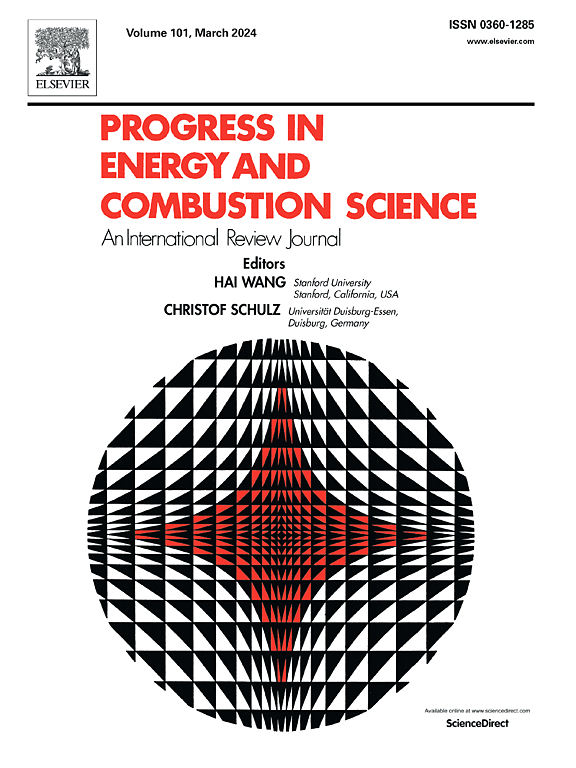厌氧消化技术的建模和优化:现状与未来展望
IF 37
1区 工程技术
Q1 ENERGY & FUELS
引用次数: 0
摘要
厌氧消化(AD)是一项重要的技术,可以利用有机废物生产可再生能源和有价值的产品,同时减少温室气体的净排放量。由于厌氧消化工艺的复杂性,厌氧消化技术的进一步发展与基础数学模型和优化技术的进步密不可分。本文对当前的厌氧消化(AD)工艺建模和优化技术以及厌氧消化(AD)产品深加工的各个方面进行了全面而严谨的评述。本文探讨了最重要的机理启发、动力学和现象学厌氧消化(AD)模型,以及最常用的确定性和随机性厌氧消化(AD)工艺优化方法。重点介绍、讨论了这些模型和方法的基础、特性和特点,并就其优缺点和各种性能指标进行了比较;还根据适当引入的标准对模型进行了排序。由于厌氧消化(AD)工艺优化在很大程度上影响着厌氧消化(AD)产品所需的处理和利用,因此还讨论了利用沼气和沼渣生产可再生能源和其他有价值产品的问题。此外,还特别关注了与厌氧消化(AD)建模和优化相关的挑战和未来研究需求,如与泡沫和微生物活动相关的建模问题、厌氧消化(AD)模型参数校准、CFD 模拟挑战、实验数据的可用性,以及厌氧消化(AD)工艺在进一步沼气和沼渣利用方面的优化。目前的研究结果表明,在这些领域取得进一步进展可以显著提高厌氧消化(AD)建模的稳健性和准确性以及厌氧消化(AD)优化性能。本文章由计算机程序翻译,如有差异,请以英文原文为准。
Modeling and optimization of anaerobic digestion technology: Current status and future outlook
Anaerobic digestion (AD) is an important technology that can be engaged to produce renewable energy and valuable products from organic waste while reducing the net greenhouse gas emissions. Due to the AD process complexity, further development of AD technology goes hand in hand with the advancement of underlying mathematical models and optimization techniques. This paper presents a comprehensive and critical review of current AD process modeling and optimization techniques as well as various aspects of further processing of AD products. The most important mechanistically inspired, kinetic, and phenomenological AD models and the most frequently used deterministic and stochastic methods for AD process optimization are addressed. The foundations, properties, and features of these models and methods are highlighted, discussed, and compared with respect to advantages, disadvantages, and various performance metrics; the models are also ranked with respect to adequately introduced criteria. Since AD process optimization affects heavily the required treatment and utilization of AD products, biogas and digestate utilization in the production of renewable energy and other valuable products is also addressed. Furthermore, special attention is devoted to the challenges and future research needs related to AD modeling and optimization, such are modeling issues related to foaming and microbial activities, AD model parameters calibration, CFD simulation challenges, availability of experimental data, and optimization of the AD process with respect to further biogas and digestate utilizations. As current research results indicate, further progress in these areas could notably improve AD modeling robustness and accuracy as well as AD optimization performance.
求助全文
通过发布文献求助,成功后即可免费获取论文全文。
去求助
来源期刊

Progress in Energy and Combustion Science
工程技术-工程:化工
CiteScore
59.30
自引率
0.70%
发文量
44
审稿时长
3 months
期刊介绍:
Progress in Energy and Combustion Science (PECS) publishes review articles covering all aspects of energy and combustion science. These articles offer a comprehensive, in-depth overview, evaluation, and discussion of specific topics. Given the importance of climate change and energy conservation, efficient combustion of fossil fuels and the development of sustainable energy systems are emphasized. Environmental protection requires limiting pollutants, including greenhouse gases, emitted from combustion and other energy-intensive systems. Additionally, combustion plays a vital role in process technology and materials science.
PECS features articles authored by internationally recognized experts in combustion, flames, fuel science and technology, and sustainable energy solutions. Each volume includes specially commissioned review articles providing orderly and concise surveys and scientific discussions on various aspects of combustion and energy. While not overly lengthy, these articles allow authors to thoroughly and comprehensively explore their subjects. They serve as valuable resources for researchers seeking knowledge beyond their own fields and for students and engineers in government and industrial research seeking comprehensive reviews and practical solutions.
 求助内容:
求助内容: 应助结果提醒方式:
应助结果提醒方式:


